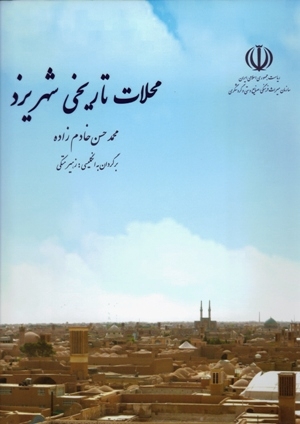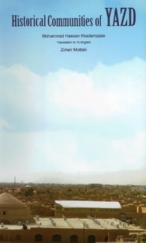Sobhan-e-Noor
Historical Communities of Yazd
Mohammad Hassan Khademezade
Translation In To English by Zoheir Mottaki
In the name of the most Almighty
Acknowledgements
The present book is the outcome of three and half years of continuous efforts inthe domain of historical city of Yazd. Such a research, studied the boundaries, formation, development, transformation and changes within the city.
Many of our communities today are the result of population growth or immigration demanding new appropriate habitats, However many others undergone certain changes nominally or anthropologically.
Early illuminations of this book dates back to several years ago. At that time, consulting architectural firms started to work on the urban fabric of Yazd mostly based on their academic backgrounds and exogenous provided criteria, which were mostly misinterpreted codes of western studies about the city. In this respect, intervention attitudes began to prescribe certain proposal among which was the division of the historical city into different regions that had no endogenous correspondent and led to numerous complications and urban predicaments later. Allegedly, new urban terms and concepts permitted the interveners to disregard the actual boundaries of the existing communities and their integrity. Such a trend led to newly fabricated boundaries and centers in which undermined the prior community structures. Furthermore, these new civic centers and elements were unable to respond to the community inhabitants' needs and demands since they were defined to serve bigger metropolitan regions than to the Yazd city structural units. As a result, these new layouts, planning, zonings, and forced service distribution per capita transformed the socio-economical structures of the historic city, which were organically formed gradually during the course of history, gave rise to the impasse of obliteration. That is why there are no traces of some communities anymore, which will be introduced later in this book. Faced with such a mischievous approach, the greatest concern throughout the book was to restore and recognize the historical structures of urban divisions of the city and research their genesis and historical unfolding to provide a reference for future studies. Such an end demanded a great deal of fieldwork to determine the boundaries of each community. At the beginning, much time was dedicated to recognize exact edges enabling every community to be clearly identified.
However, after several months of study and research, it was found that such exact and clearcut boundaries could not be achieved and would not be beneficial either. In fact, it was possible to classify every single residential unit in one of the neighboring communities based on social interest. Finally, we came to this conclusion that the Community boundaries would be best described in a hybrid continuum of urban elements rather than a clear-cut line. That was why though to some extent exact edges were recognized, they were set aside and not applied due to lack of efficiency. In its place, the proximity of the community passages and a bright sphere around the community center were depicted.
The basic criteria to select communities were the written inscriptions including historical books, endowment's documents, itineraries, and still existing popular urban centers (field research). In certain cases, several names were noted in historical documents, which were unknown through the city and not anymore recognized by dwellers. Therefore, a chapter at the end of the book is dedicated to the name of these vanished communities. Since the book preparation was considerably time-consuming, many people were involved hat I wish the research outcome to some extent compensated their contributions. I would like to appreciate and thank them personally who are as the following according to the process:
Mr. Susan Azhdar with whom the field research initiated and Mr. Mahmoud Pourserajian Who accompanied us later. Alireza Zāre' Bidoki, Ismael Zāre' Khormizi who greatly and kindly accomplished the digital preparation. I appreciate Mrs. Fatemeh Islami; Mrs. Fatemeh Danesh-Yazdi and Mrs. Na'imeh Hakim, who helped me with the documents extraction process. I am thankful to Mojtaba Farahmand, Majid Khademradeh and Hamid Khani for their cooperation and feel great respect for the outstanding aerial photos preparation to Mr. Khebreh-Dast.
I am also grateful to my dear friend Mr. Ardashir Shokoufeh, the head of Sobhan-e-Noor publishing who really helped throughout the demanding process.
Here I feel necessary to acknowledge and express gratitude to the devoted and conscientious efforts of Zoheir Mottaki Who due to my repetitious revisions went into great lenght to translate the book severally and devise an English glossary with such an accuracy and proficiency from the beginning to the end.
At the end, I am thankful God the almighty that though certain bureaucratic predicaments were in the way, the book is finally realized.
Here I would like to make an apology to the professionals and academics for any possible shortcomings and humbly ask for your comments for future improvements.
Mohammad-Hasan Khadem-Zadeh
(Source:Mohammad Hassan Khademzade: Historical Communities of Yazd, Translation In To English by Zoheir Mottaki, First Published in 2007; Circulation: 1386, Publishing: Sobhan-e-Noor Cultural Heritage Base Of Historical Yazd City, Achnowledgements)


